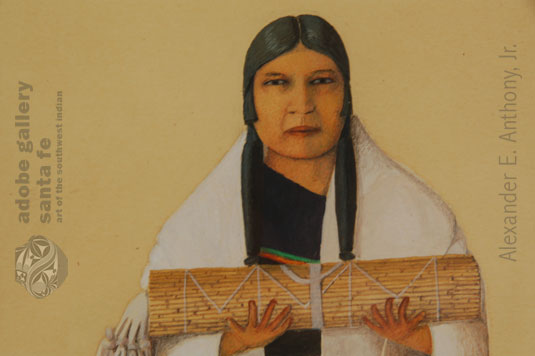Polelonema Painting of a Hopi Bride [SOLD]
+ Add to my watchlist Forward to Friend
- Category: Paintings
- Origin: Hopi Pueblo, Hopituh Shi-nu-mu
- Medium: opaque watercolor
- Size:
13” x 9-1/2” image;
22-1/4” x 18-3/4” framed - Item # C4059.03 SOLD
It is generally accepted that Fred Kabotie is the greatest Hopi painter of all times, and that Waldo Mootzka and Otis Polelonema trade off as the second greatest. Otis Polelonema (1902-1981) Loadamosiva - Springtime was, of course, a Santa Fe Indian School student (1914-1920) and credited his experience there and his contact with Superintendent and Mrs. De Huff as a major influence on him in the art field.
Several boys, while still in school, received encouragement after class from Superintendent and Mrs. De Huff in their home at the Indian School. Among them were Ma-Pe-Wi, Fred Kabotie, Otis Polelonema, and Awa Tsireh. Dr. Edward Lee Hewett said of them "these young Indians were simply protected from learning art by our methods and enabled to go on in their own way in which no one can teach them."
Dorothy Dunn stated that Polelonema was a strong artist and a true primitive and these facts jump straight to the eye. She further stated "Much of the charm of the paintings is inherent in their straightforward and rugged naiveté. They reflect the artist's ability to override rules to the direct creation of his own techniques and devices in the matter of such bugaboos as perspective, light and shade, and color theory. He masters them all, and how delightfully."
Polelonema won the Ann Evans Memorial Award in 1954 at the Denver Art Museum, followed by the Southwest Association on Indian Affairs Award and the Denman Prize in New Mexico exhibitions. His works were included in every major exhibit, national and international, in the early 1900s.
Polelonema painted images of a Hopi Bride several times. There is one in The Elkus Collection at the California Academy of Sciences, painted about 1930; another one in the Museum of Northern Arizona collection, both of which are similar to this one but with some differences. He apparently painted all of them in the 1930s.
The bride is wearing her handmade white cotton wedding manta over her shoulders, wears a white wedding sash and carries a second wedding sash in the reed suitcase. Her hair has been let down from the unmarried maiden whorls, an indication that she is now married. The painting focuses on the single figure of a bride, with no distractions of background imagery, typical of his earliest painting style.
![]() After leaving the Santa Fe Indian School, Polelonema attended Santa Fe Public High School for one year, then returned to his home village of Shungopavi at Hopi, where he spent the remainder of his life. He became involved in traditional Hopi activities. He never painted as often as he had done in the 1930s although he did paint occasionally until the mid-1970s. He passed away in 1981 during the annual Solstice ceremony celebration.
After leaving the Santa Fe Indian School, Polelonema attended Santa Fe Public High School for one year, then returned to his home village of Shungopavi at Hopi, where he spent the remainder of his life. He became involved in traditional Hopi activities. He never painted as often as he had done in the 1930s although he did paint occasionally until the mid-1970s. He passed away in 1981 during the annual Solstice ceremony celebration.
Condition: this Polelonema Painting of a Hopi Bride is in original condition
Provenance: originally from the Richard M. Howard collection, Santa Fe dealer and collector, from whom we acquired it. We sold it to a Santa Fe family in 2004, from whom we now have it back because they are moving to Colorado.
References:
- Seymour, Tryntje Van Ness. When the Rainbow Touches Down, 1988.
- Washburn, Dorothy K., editor. The Elkus Collection, 1984.

- Category: Paintings
- Origin: Hopi Pueblo, Hopituh Shi-nu-mu
- Medium: opaque watercolor
- Size:
13” x 9-1/2” image;
22-1/4” x 18-3/4” framed - Item # C4059.03 SOLD



